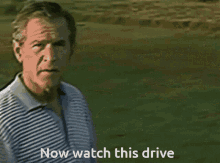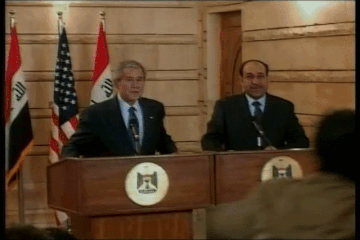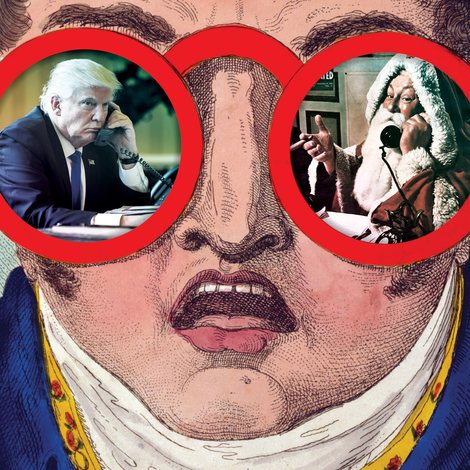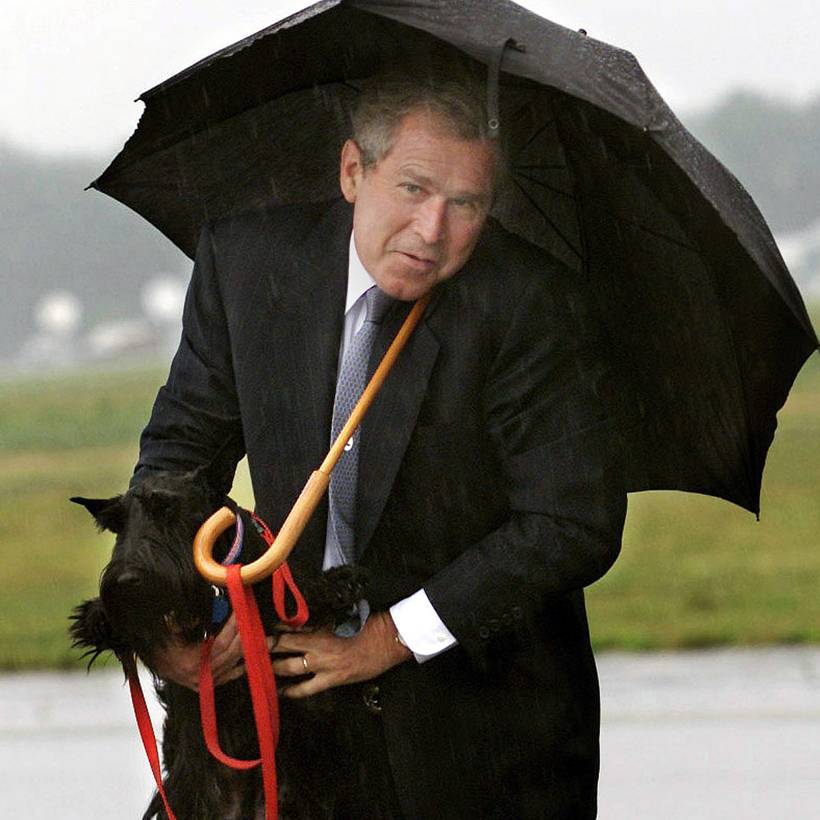Twenty-five years after the turn of the century, the 2000s are back. Low-waisted jeans are in again. Oasis has returned. Countless movies from the early aughts are getting their sequels. (See: Freakier Friday, The Devil Wears Prada 2.) But no one could have anticipated the return of … George W. Bush.
For the Gen Z set, many of whom were in diapers when “Dubya” was president, trending TikTok videos of the 79-year-old Texan—tagged #Bushcore and set to Nicki Minaj songs—evoke a time when everything seemed like it was, well, a grand old party.
It all started at Trump’s second inauguration, in January, when a clip of Bush raising his eyebrows and smirking as Trump gave his address in the Capitol Rotunda went viral, receiving millions of views on YouTube and spawning myriad GIFs and memes. And rather than die down post-inauguration, the Bush fervor has only intensified, as young Internet sleuths unearth gem after forgotten gem.

In one viral clip from 2007, Bush dances and plays the bongos with the KanKouran West African Dance Company on the White House lawn to mark the first-ever annual World Malaria Day. (He also sword-dances with Saudis and tap-dances for White House reporters.) In another, from 2008, he congratulates Pope Benedict XVI following his White House address by saying, “Thank you, Your Holiness. Awesome speech!”
His parting words to reporters following a 2002 interview on terrorism, which he gave at Maine’s Cape Arundel Golf Club—“Now watch this drive”—are particularly popular. “I quote ‘Now watch this drive’ at least once a day,” says a 25-year-old Washington, D.C.–based wealth-management associate. “I think they are so funny,” adds a 26-year-old banker based in New York. “I always watch them.” (Both voted for Kamala Harris in 2024.)

To older generations who remember Bush’s many missteps, not least the Iraq War and its financial and human costs, the rise of “Bushcore” is baffling. “As shocking as it is to me,” says Richard Haass, who served as president of the Council on Foreign Relations from 2003 to 2023 and worked with both George H. W. Bush and George W. Bush, “I expect it would just play very well for people who were too young to remember.”
When he was elected, in the year 2000, “President Bush was viewed as the guy you’d want to have a beer with,” says Robert Draper, the historian and best-selling author of two Bush biographies. (Though it would have had to have been a non-alcoholic beer, as Bush gave up drinking in 1986.)
By the time he left office, on January 20, 2009, however, the public had largely soured on the former Texas governor. The Great Recession was in full swing, his claim that Saddam Hussein had weapons of mass destruction turned out to be false and based on cherry-picked intelligence, the war on terror in Iraq and Afghanistan had cost three trillion dollars and thousands of American and civilian lives, and his administration had failed to effectively address Hurricane Katrina (whose upcoming 20th anniversary is sparking a whole new round of outrage on the Internet).
His approval ratings, which in the months following the September 11 attacks had reached 90 percent, the highest for an American president since polling began, had plummeted to 33 percent. (For context: Nixon’s ratings were at 24 percent in the days before his resignation over Watergate.)

But Gen Z is too young to remember all that. To them, Bush is not the disastrously inept leader prone to groupthink that veteran critics view him as, but, rather, a goofy, endearing grandfather figure whose gaffes—long referred to as Bushisms—are the source of endless entertainment. Some TikTokers have even begun calling him “the Michael Scott of presidents.”
Approval ratings reflect this shift. In January, a Gallup poll found Bush to be the second-most-popular living president, behind Obama and ahead of Clinton.
Draper thinks there’s more to this resurgence in popularity than a viral meme. “There’s no question in my mind that Bush’s approval ratings are benefiting from the chaos and divisiveness resulting from the current administration,” he says. “His respectfulness towards institutions lends Bush a kind of sweet-granddad aura that stands in jarring contrast to President Trump.”
“My guess is a lot of these young people are not overly burdened with a knowledge of history and policy,” Haass says. “So they wouldn’t be turned off, say, by some of what he did as president—for example, the Iraq War.”
Gen Z seems particularly taken with the idea that Bush, despite being a Republican, was sympathetic toward immigrants and minorities. Following his presidency, Bush took up painting—with less skill than Churchill and more than Hunter Biden—and a book of his oil works, released in 2021 and titled Out of Many, One: Portraits of America’s Immigrants, features 43 portraits of American immigrants, each of whom Bush met with personally.

One is Thear Suzuki, a Cambodian immigrant who escaped a genocide in her country and re-settled in the U.S. in 1981. Another is Paula Rendon, the Bush family’s longtime housekeeper and nanny, who left Mexico in 1959 and whom Bush considered “a second mother.”
“My message is let’s look at each immigrant here in the country and honor them as a child of God. And let’s recognize the powerful influence that the newly arrived can have on our soul,” Bush said in an interview with NBC in 2021.
In a clip posted by the TikTok account @thelibsareresisting, from a 2011 interview in which Bush talks about sharing values with Mexican Americans, the caption reads, “Back when they had empathy.” One user commented, “A couple presidents later: They are eating the dogs and cats!” Another: “I’d take 1000 years of this one vs a solitary millisecond of that tangerine turd.”
And while Gen Z may not remember 9/11 firsthand, the period of national unity and patriotism that followed the attacks has since become part of the country’s collective memory. Both right and left rallied around the president, who stepped up to the plate, both as a leader in a time of national mourning and, literally, when he threw the first pitch at Yankee Stadium on October 30, 2001—a moment many look back on today as the emblem of resilience following the deadliest terrorist attack on American soil in history.
One video, posted by Claire Edwards, an Arizona-based influencer with more than 486,000 followers on TikTok, features a Gossip Girl audio clip of Chuck Bass telling Blair Waldorf, “Don’t marry him.” The video’s caption: “When I’m about to walk down the aisle but George W Bush when he found out about 9/11 shows up.”
Given Gen Z’s distaste for America’s current involvement in the Middle East—only 9 percent of Americans under the age of 35 approve of Israel’s military action in Gaza, for which the U.S. supplies the majority of the weapons—there’s an element of irony to Bush’s popularity. But the Internet is notoriously fickle.

In yet another viral clip from 2008, Bush dodges a pair of shoes thrown at him by the Iraqi journalist Muntadhar al-Zaidi during a press conference in Baghdad. “If you want the facts, it’s a size 10 shoe that he threw,” Bush said in response, eliciting laughs from the other reporters in the room. (“This invasion entered my country, destroyed my land, my education, defense, everything. Destroyed everything in my country,” al-Zaidi, who was sentenced to three years in jail, said when reached for comment this week.)
For some, the gravity of that moment seems to have slipped away—just another Bush folly softened by time. Last month, the comedian John Mulaney called the shoe incident “the funniest thing that’s ever happened on television in my life.”
“He could laugh at himself, he freely cried, he loved dogs, and he was unabashedly a man of faith. That all this would provoke nostalgia is unsurprising,” Draper says. “But let’s not get carried away in interpreting the public’s current evaluation of him.… ‘Not the worst living president’ hardly counts as a glowing endorsement.”
Carolina de Armas and Paulina Prosnitz are Junior Editors at Air Mail

